 Facebook
Facebook
 X
X
 Instagram
Instagram
 TikTok
TikTok
 Youtube
Youtube
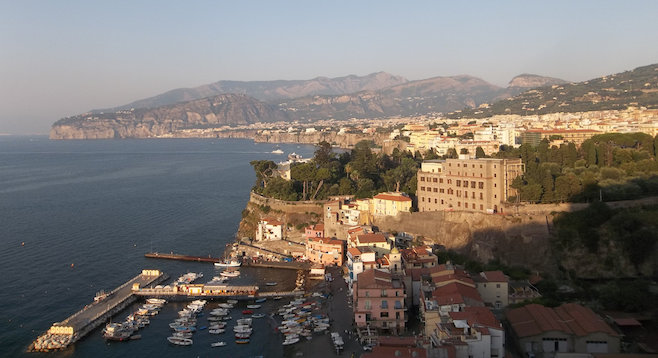
Sorrento is well positioned as the gateway to several locations of interest in southern Italy, including Pompeii, Capri, and the spectacular, meandering Amalfi Coast. But the town of 17,000 is also worth exploring in its own right.
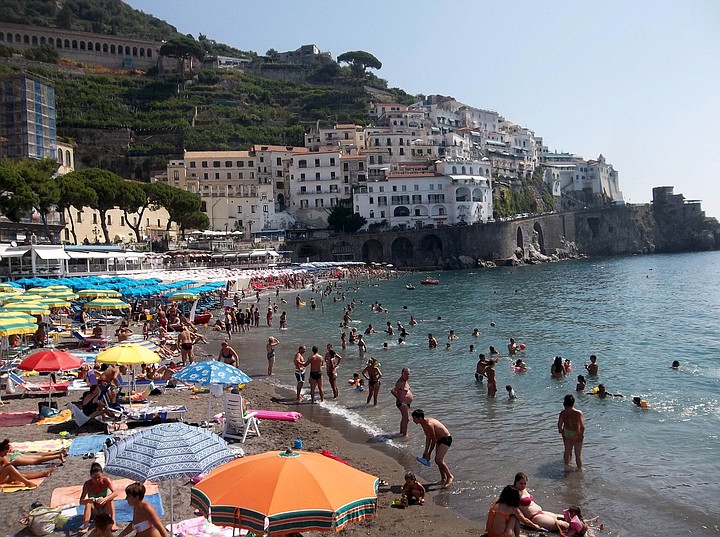
Sorrento is popular with international travelers for its relaxed ambience and spectacular scenery. Those with an affinity for anything lemon will find sour heaven here with the abundance of limoncello and lemon-related items, products of the nearby citrus groves that adorn seaside terraces. Sorrento also produces quality olive oil from local olive groves.
The circumvesuviana connection with Naples (about 50 kilometers north) and Pompeii make a visit here convenient if you're exploring Italy without a car. The circumvesuviana is an above-ground subway, efficient but often hot and crowded. The hour-long ride from Naples stops at the Sorrento train station, a short walk from town.
Upon my arrival, I walked a few blocks down Corso Italia to Piazza Tasso, the main square just past the statue of St. Anthony (the patron saint of Sorrento), that greets visitors. The piazza is marked by another statue, that of its namesake, Torquato Tasso, a local Renaissance poet. I took a bus up the winding hill to the homey and reasonably priced Hotel Elios. My room was simple, but included a balcony with a spectacular view of the Bay of Naples, Mount Vesuvius and Capri. Elios is run by friendly Gianna, who greeted me with a welcoming smile and provided helpful information about the town.
A charming middle-aged gentleman served breakfast in the morning. Quite friendly and chatty, he asked where I was from. When I told him I was originally from New Orleans, he told me about his days in the Italian navy visiting Bourbon Street in the French Quarter. He warned me, in a warmly paternal tone, about pickpockets on the circumsuviana. When he discovered I had been teaching English, he inquired as to the correct response to a woman telling him, “I never want to see you again.”
“Is it 'Me either' or ‘Me neither’?”
He had replied “Me either” to the young lady and wanted to know if this was grammatically correct. (Mamma mia!)
Buses whisk visitors down the hillside back into town, but I opted to walk each morning, pausing at the overlook to savor the breathtaking view of Sorrento below (top), alongside the deep-blue Bay of Naples.
With its colorful, relaxed atmosphere, Sorrento is a great town for walking. You can peruse the shops near the city center or follow a winding road from the seaside cliffs down to a tiny public beach near the fishing village alongside Marina Grande. You can also opt to take a lift to the sea and rent a lounge chair near the pier at Marina Piccola. Pick up a gelato to take with you. The finest in town can be found at Gelateria David, two blocks from the train station. Via San Cesareo is the main street in the old section of town where you will find shops selling a variety of lemon products. On summer evenings, Corso Italia, the main street in Sorrento, features the passegiata (stroll), where locals (and visitors) strut their stuff – always fun to watch or participate in.
Some of the prime museums locally are Correale Museum and Museo Bottega della Tarsialignea, a woodcarving museum. A Salvador Dali exhibit was on display during my visit. In summer, there are concerts and art exhibits in Piazza San Francesco alongside the medieval church of the same name.
Sorrento has a history that predates the Roman era. The old town, separated by a ravine from the new town, was an important trading post in the Middle Ages and retains its narrow roads. In the 19th century, Sorrento became a popular spot for Europeans traveling through Southern Italy from Rome or on a Grand Tour. These included the likes of Byron, Keats, Dickens, Goethe and Nietzche, among others. It was also popular with Turk invaders, who sacked the city in 1558 looking to enrich themselves.
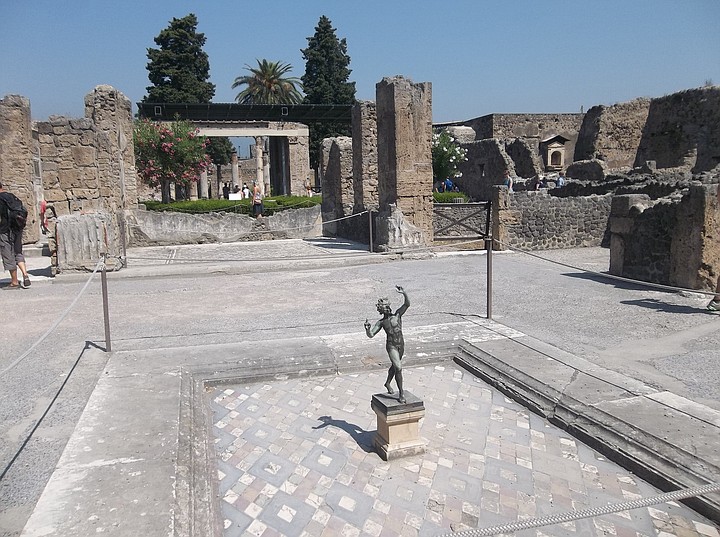
For those with an interest in classical history, visiting this region of Italy offers a particularly special opportunity to investigate the ruins of antiquity via day trips from Sorrento. Pompeii to the north and Paestum, an impressive collection of Greek temples, to the south of the Amalfi Coast provide exquisite, mind-enriching alternatives to days of relaxing on the beach and sightseeing the spectacular scenery.
I had visited Pompeii many years ago, but this visit to the ill-fated city frozen in time was as fresh and awe-inspiring as ever. Having studied up a bit on ancient classical sites before visiting here, I was more knowledgeable now about the ancient history of Pompeii and the circumstances surrounding its demise in 79 A.D. I sat in the theater, marveled at the Temple of Jupiter in the Forum, and visited the House of the Faun, the House of the Tragic Poet, the baths, the brothel, and even an ancient fast food joint. It's not required to have an interest in history to be captivated by Pompeii.
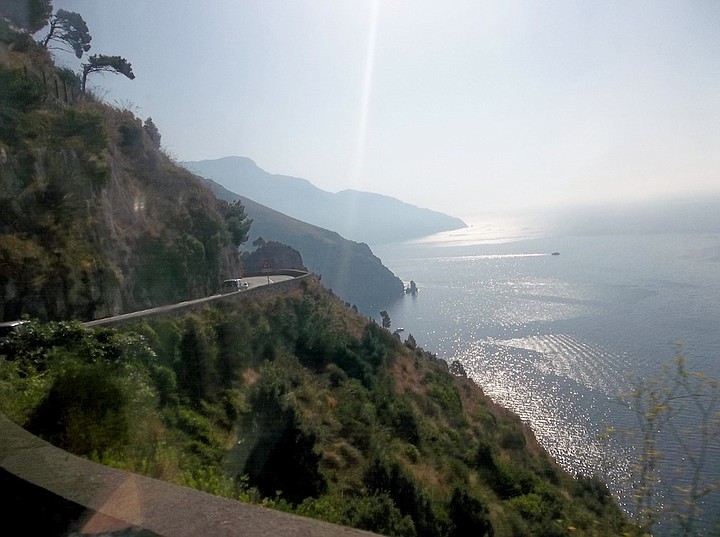
The Amalfi Coast can be explored via bus, taxi or boat. I chose the former, arriving early at the bus stop to assure a seat on the right side of the bus. Those on the left side get left out of some of the most attractive views (effectively defeating the purpose of the journey). Arriving early not only increases your chances of getting a good seat, but allows maximum time to explore the towns along the coast, especially Amalfi and Positano.
The Amalfi Coast bus ride winds along limestone cliffs amidst exquisite scenery. The view of rolling hills dotted with hillside homes overlooking the stunning Gulf of Salerno reminded me of Big Sur. The ride concludes at the town of Amalfi, where you can spread out a towel on the attractive beach or navigate the town by foot while checking out the trendy shops. There are some decent hiking trails from Amalfi, especially a short one to the nearby town of Atrani. You can also opt for a connection heading further down the coast past Ravello – and Gore Vidal’s palatial white hillside villa – to the well-preserved Greek ruins at Paestum.
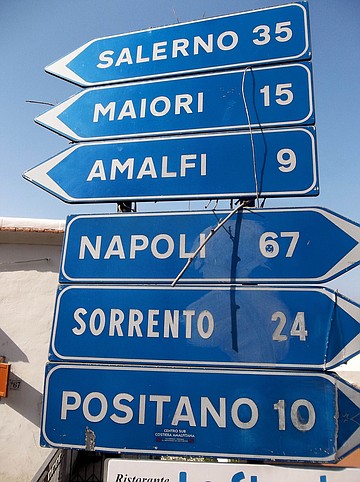
Positano, between Sorrento and Amalfi, is a popular, worthwhile spot to visit as well, more chic than Sorrento and with a better beach. But catching a bus back to Sorrento from Positano on a summer afternoon can be tricky as the buses tend to fill up. Catching a boat back may be a better bet. If you decline to get off here, at least take in the postcard view of the seaside village.
The island of Capri is also accessible via ferry from Sorrento. The Blue Grotto is a prime attraction there. I visited Capri years ago, but skipped it on this journey due to lack of time.
For those with limited time on a visit to this area, crafting an itinerary can be tricky. But a few days in Sorrento, with access to all the experiences this area has to offer, can scarcely be matched anywhere in Europe.


Sorrento is well positioned as the gateway to several locations of interest in southern Italy, including Pompeii, Capri, and the spectacular, meandering Amalfi Coast. But the town of 17,000 is also worth exploring in its own right.

Sorrento is popular with international travelers for its relaxed ambience and spectacular scenery. Those with an affinity for anything lemon will find sour heaven here with the abundance of limoncello and lemon-related items, products of the nearby citrus groves that adorn seaside terraces. Sorrento also produces quality olive oil from local olive groves.
The circumvesuviana connection with Naples (about 50 kilometers north) and Pompeii make a visit here convenient if you're exploring Italy without a car. The circumvesuviana is an above-ground subway, efficient but often hot and crowded. The hour-long ride from Naples stops at the Sorrento train station, a short walk from town.
Upon my arrival, I walked a few blocks down Corso Italia to Piazza Tasso, the main square just past the statue of St. Anthony (the patron saint of Sorrento), that greets visitors. The piazza is marked by another statue, that of its namesake, Torquato Tasso, a local Renaissance poet. I took a bus up the winding hill to the homey and reasonably priced Hotel Elios. My room was simple, but included a balcony with a spectacular view of the Bay of Naples, Mount Vesuvius and Capri. Elios is run by friendly Gianna, who greeted me with a welcoming smile and provided helpful information about the town.
A charming middle-aged gentleman served breakfast in the morning. Quite friendly and chatty, he asked where I was from. When I told him I was originally from New Orleans, he told me about his days in the Italian navy visiting Bourbon Street in the French Quarter. He warned me, in a warmly paternal tone, about pickpockets on the circumsuviana. When he discovered I had been teaching English, he inquired as to the correct response to a woman telling him, “I never want to see you again.”
“Is it 'Me either' or ‘Me neither’?”
He had replied “Me either” to the young lady and wanted to know if this was grammatically correct. (Mamma mia!)
Buses whisk visitors down the hillside back into town, but I opted to walk each morning, pausing at the overlook to savor the breathtaking view of Sorrento below (top), alongside the deep-blue Bay of Naples.
With its colorful, relaxed atmosphere, Sorrento is a great town for walking. You can peruse the shops near the city center or follow a winding road from the seaside cliffs down to a tiny public beach near the fishing village alongside Marina Grande. You can also opt to take a lift to the sea and rent a lounge chair near the pier at Marina Piccola. Pick up a gelato to take with you. The finest in town can be found at Gelateria David, two blocks from the train station. Via San Cesareo is the main street in the old section of town where you will find shops selling a variety of lemon products. On summer evenings, Corso Italia, the main street in Sorrento, features the passegiata (stroll), where locals (and visitors) strut their stuff – always fun to watch or participate in.
Some of the prime museums locally are Correale Museum and Museo Bottega della Tarsialignea, a woodcarving museum. A Salvador Dali exhibit was on display during my visit. In summer, there are concerts and art exhibits in Piazza San Francesco alongside the medieval church of the same name.
Sorrento has a history that predates the Roman era. The old town, separated by a ravine from the new town, was an important trading post in the Middle Ages and retains its narrow roads. In the 19th century, Sorrento became a popular spot for Europeans traveling through Southern Italy from Rome or on a Grand Tour. These included the likes of Byron, Keats, Dickens, Goethe and Nietzche, among others. It was also popular with Turk invaders, who sacked the city in 1558 looking to enrich themselves.

For those with an interest in classical history, visiting this region of Italy offers a particularly special opportunity to investigate the ruins of antiquity via day trips from Sorrento. Pompeii to the north and Paestum, an impressive collection of Greek temples, to the south of the Amalfi Coast provide exquisite, mind-enriching alternatives to days of relaxing on the beach and sightseeing the spectacular scenery.
I had visited Pompeii many years ago, but this visit to the ill-fated city frozen in time was as fresh and awe-inspiring as ever. Having studied up a bit on ancient classical sites before visiting here, I was more knowledgeable now about the ancient history of Pompeii and the circumstances surrounding its demise in 79 A.D. I sat in the theater, marveled at the Temple of Jupiter in the Forum, and visited the House of the Faun, the House of the Tragic Poet, the baths, the brothel, and even an ancient fast food joint. It's not required to have an interest in history to be captivated by Pompeii.

The Amalfi Coast can be explored via bus, taxi or boat. I chose the former, arriving early at the bus stop to assure a seat on the right side of the bus. Those on the left side get left out of some of the most attractive views (effectively defeating the purpose of the journey). Arriving early not only increases your chances of getting a good seat, but allows maximum time to explore the towns along the coast, especially Amalfi and Positano.
The Amalfi Coast bus ride winds along limestone cliffs amidst exquisite scenery. The view of rolling hills dotted with hillside homes overlooking the stunning Gulf of Salerno reminded me of Big Sur. The ride concludes at the town of Amalfi, where you can spread out a towel on the attractive beach or navigate the town by foot while checking out the trendy shops. There are some decent hiking trails from Amalfi, especially a short one to the nearby town of Atrani. You can also opt for a connection heading further down the coast past Ravello – and Gore Vidal’s palatial white hillside villa – to the well-preserved Greek ruins at Paestum.

Positano, between Sorrento and Amalfi, is a popular, worthwhile spot to visit as well, more chic than Sorrento and with a better beach. But catching a bus back to Sorrento from Positano on a summer afternoon can be tricky as the buses tend to fill up. Catching a boat back may be a better bet. If you decline to get off here, at least take in the postcard view of the seaside village.
The island of Capri is also accessible via ferry from Sorrento. The Blue Grotto is a prime attraction there. I visited Capri years ago, but skipped it on this journey due to lack of time.
For those with limited time on a visit to this area, crafting an itinerary can be tricky. But a few days in Sorrento, with access to all the experiences this area has to offer, can scarcely be matched anywhere in Europe.
Comments